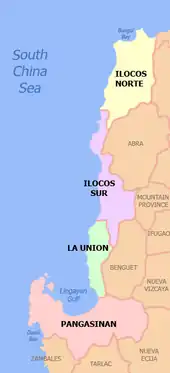San Fabian | |
|---|---|
| Municipality of San Fabian | |
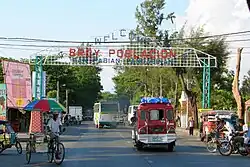 Poblacion | |
 Flag  Seal | |
| Anthem: Baley Kon San Fabian | |
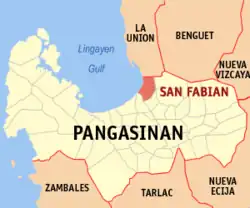 Map of Pangasinan with San Fabian highlighted | |
OpenStreetMap | |
.svg.png.webp) San Fabian Location within the Philippines | |
| Coordinates: 16°09′N 120°27′E / 16.15°N 120.45°E | |
| Country | Philippines |
| Region | Ilocos Region |
| Province | Pangasinan |
| District | 4th district |
| Founded | March 21, 1717 |
| Named for | Pope Fabian |
| Barangays | 34 (see Barangays) |
| Government | |
| • Type | Sangguniang Bayan |
| • Mayor | Marlyn E. Agbayani |
| • Vice Mayor | Constante B. Agbayani |
| • Representative | Christopher P. de Venecia |
| • Municipal Council | Members |
| • Electorate | 57,896 voters (2022) |
| Area | |
| • Total | 81.28 km2 (31.38 sq mi) |
| Elevation | 7.0 m (23.0 ft) |
| Highest elevation | 110 m (360 ft) |
| Lowest elevation | −3 m (−10 ft) |
| Population (2020 census)[3] | |
| • Total | 87,428 |
| • Density | 1,100/km2 (2,800/sq mi) |
| • Households | 22,669 |
| Economy | |
| • Income class | 1st municipal income class |
| • Poverty incidence | 11.46 |
| • Revenue | ₱ 231.2 million (2020) |
| • Assets | ₱ 206.6 million (2020) |
| • Expenditure | ₱ 212.3 million (2020) |
| • Liabilities | ₱ 26.59 million (2020) |
| Service provider | |
| • Electricity | Dagupan Electric Corporation (DECORP) |
| Time zone | UTC+8 (PST) |
| ZIP code | 2433 |
| PSGC | |
| IDD : area code | +63 (0)75 |
| Native languages | Pangasinan Ilocano Tagalog |
| Website | www |
San Fabian, officially the Municipality of San Fabian (Pangasinan: Baley na San Fabian; Ilocano: Ili ti San Fabian; Tagalog: Bayan ng San Fabian), is a 1st class municipality in the province of Pangasinan, Philippines. According to the 2020 census, it has a population of 87,428 people.[3]
Etymology
The town got its name after Saint Fabian during the Spanish era.
History
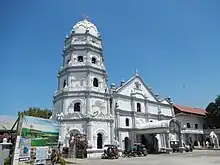
The town used to be called Angio, and had been a mission territory of friars of the Dominican Order during the Spanish era. It is named after Saint Fabian, who was a pontiff and saint of the Roman Catholic Church.
Around 1818, San Fabian had a boundary dispute with Mangaldan. The boundary between the two towns was the Angalacan river, which sometimes overflows because of floods. The boundary dispute was settled in 1900, when the mayor of San Fabian agreed to meet the mayor of Mangaldan and the two reached an agreement with a boundary marker being erected at Longos between the towns of San Fabian and Mangaldan. The agreement was signed by Juan Ulanday, Nicolas Rosa, Vicente Padilla, Marcelo Erfe, and approved by the American Commander Capt. Ferguson.[5]
During the Philippine–American War, hundreds of Pangasinense soldiers and soldiers of the Philippine government died in San Fabian battling the Americans.[6] After the pacification of Pangasinan by the United States, the first town President of San Fabian was Ińigo Dispo. In 1903, the town of Alava became a part of San Fabian and became a mere village or barrio.[7]
During World War II, the liberation of US Naval and Marine forces in Pangasinan started when troops under Gen. Walter Krueger landed on Lingayen and San Fabian beaches. San Fabian landing zones were called White and Blue beaches, names which continue until the present time.[8]
In October 2009, San Fabian was among the places heavily affected by the floods caused by the release of water by the San Roque Dam at Rosales during the height of the Typhoon Pepeng.[9]
Geography
San Fabian is geographically located in the northern portion in Pangasinan, bordering the provincial boundaries of La Union. It has a land area of 8,129 hectares.[10] It is bounded in the north by Rosario (La Union), Sison in the northeast, Mangaldan in the south, Pozorrubio and San Jacinto in the southeast, Dagupan in the southwest, and in the west by Lingayen Gulf.
San Fabian is 28 kilometres (17 mi) from Lingayen and 234 kilometres (145 mi) from Manila.
Barangays
San Fabian is politically subdivided into 34 barangays. Each barangay consists of puroks and some have sitios.
- Alacan
- Ambalangan-Dalin
- Angio
- Anonang
- Aramal
- Bigbiga
- Binday
- Bolaoen
- Bolasi
- Cabaruan
- Cayanga
- Colisao
- Gumot
- Inmalog Norte
- Inmalog Sur
- Lekep-Butao
- Lipit-Tomeeng
- Longos Central
- Longos Proper
- Longos-Amangonan-Parac-Parac Fabrica
- Mabilao
- Nibaliw Central
- Nibaliw East
- Nibaliw Magliba
- Nibaliw Narvarte (Nibaliw West Compound)
- Nibaliw Vidal (Nibaliw West Proper)
- Palapad
- Poblacion
- Rabon
- Sagud-Bahley
- Sobol
- Tempra-Guilig
- Tiblong
- Tocok
Climate
| Climate data for San Fabian, Pangasinan | |||||||||||||
|---|---|---|---|---|---|---|---|---|---|---|---|---|---|
| Month | Jan | Feb | Mar | Apr | May | Jun | Jul | Aug | Sep | Oct | Nov | Dec | Year |
| Mean daily maximum °C (°F) | 31 (88) |
31 (88) |
33 (91) |
34 (93) |
34 (93) |
33 (91) |
32 (90) |
31 (88) |
31 (88) |
32 (90) |
31 (88) |
31 (88) |
32 (90) |
| Mean daily minimum °C (°F) | 21 (70) |
21 (70) |
23 (73) |
25 (77) |
25 (77) |
25 (77) |
25 (77) |
24 (75) |
24 (75) |
24 (75) |
23 (73) |
22 (72) |
24 (74) |
| Average precipitation mm (inches) | 4.3 (0.17) |
19.1 (0.75) |
27.3 (1.07) |
45.2 (1.78) |
153.3 (6.04) |
271.3 (10.68) |
411.1 (16.19) |
532.0 (20.94) |
364.2 (14.34) |
182.5 (7.19) |
56.3 (2.22) |
24.4 (0.96) |
2,091 (82.33) |
| Average rainy days | 3 | 2 | 3 | 5 | 14 | 17 | 22 | 23 | 21 | 13 | 7 | 4 | 134 |
| Source: World Weather Online[11] | |||||||||||||
Demographics
| Year | Pop. | ±% p.a. |
|---|---|---|
| 1903 | 10,022 | — |
| 1918 | 15,845 | +3.10% |
| 1939 | 19,362 | +0.96% |
| 1948 | 23,997 | +2.41% |
| 1960 | 29,704 | +1.79% |
| 1970 | 35,014 | +1.66% |
| 1975 | 39,054 | +2.21% |
| 1980 | 42,018 | +1.47% |
| 1990 | 51,904 | +2.14% |
| 1995 | 59,904 | +2.72% |
| 2000 | 66,274 | +2.19% |
| 2007 | 74,005 | +1.53% |
| 2010 | 77,899 | +1.88% |
| 2015 | 83,025 | +1.22% |
| 2020 | 87,428 | +1.02% |
| Source: Philippine Statistics Authority[12][13][14][15] | ||
Economy
Government
Local government
San Fabian, belonging to the fourth congressional district of the province of Pangasinan, is governed by a mayor designated as its local chief executive and by a municipal council as its legislative body in accordance with the Local Government Code. The mayor, vice mayor, and the councilors are elected directly by the people through an election which is being held every three years.
The present Mayor of San Fabian is Marlyn Espino-Agbayani, the second woman to be elected as the Local Chief Executive of the said town. Current Vice Mayor is former Mayor Constante Batrina Agbayani, the husband of the current Mayor. Former Vice Mayor Dr. Leopoldo N. Manalo is the only Vice Mayor to be elected and have completed the three-term limit on the said position. Former Mayor Irene F. Libunao is the first woman to be elected as Mayor in the municipality, who served from 2010 to 2013. Marinor Baltazar-De Guzman, the town's Vice Mayor from 2019 to 2022, became the first woman to be elected Board Member representing the 4th Provincial District of the Sangguniang Panlalawigan of Pangasinan.
Elected officials
| Position | Officials | LGU Designation |
|---|---|---|
| Municipal Mayor | Marlyn E. Agbayani | Local Chief Executive |
| Municipal Vice Mayor | Constante B. Agbayani | Sangguniang Bayan Presiding Officer |
| Municipal Councilors | Chelsea Mae N. Narvasa | Sangguniang Bayan Minority Floor Leader |
| Roberto O. Quirimit | Sangguniang Bayan Majority Floor Leader | |
| Errol R. Sison | Sangguniang Bayan Member | |
| Marieta C. Cuaresma | Sangguniang Bayan Member | |
| Hercules P. Magliba | Sangguniang Bayan Member | |
| Kimberly G. Bandarlipe | Sangguniang Bayan Assistant Minority Floor Leader | |
| Riemzie A. Abrio | Sangguniang Bayan Member | |
| Rolando J. Pedralvez | Sangguniang Bayan Member | |
| Efren R. Fajardo | Sangguniang Bayan Ex-officio Member
President, Liga ng mga Barangay - San Fabian | |
| Mary Ruth Victoria H. Agbayani | Sangguniang Bayan Ex-officio Member
President, Pambayang Pederasyon ng SK - San Fabian |
Notable personalities
- Andres Narvasa, a former Chief Justice
- Perfecto V. Fernandez, a Filipino lawyer
- Bella Poarch, a Filipino-American singer and social media star
Gallery
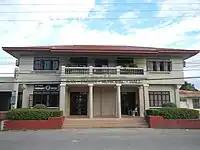 Bulwagan ng Sangguniang Bayan
Bulwagan ng Sangguniang Bayan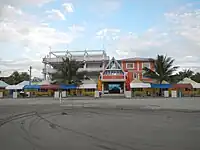 Amianan Boating World Resort
Amianan Boating World Resort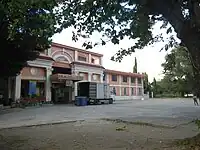 Archdiocesan School of San Fabián
Archdiocesan School of San Fabián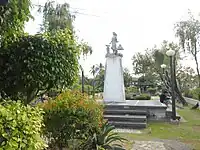 Monument in the Mutya ng Pilipinas Park
Monument in the Mutya ng Pilipinas Park
References
- ↑ Municipality of San Fabian | (DILG)
- ↑ "2015 Census of Population, Report No. 3 – Population, Land Area, and Population Density" (PDF). Philippine Statistics Authority. Quezon City, Philippines. August 2016. ISSN 0117-1453. Archived (PDF) from the original on May 25, 2021. Retrieved July 16, 2021.
- 1 2 Census of Population (2020). "Region I (Ilocos Region)". Total Population by Province, City, Municipality and Barangay. Philippine Statistics Authority. Retrieved July 8, 2021.
- ↑ "PSA Releases the 2018 Municipal and City Level Poverty Estimates". Philippine Statistics Authority. December 15, 2021. Retrieved January 22, 2022.
- ↑ Rosario Cortes: Pangasinan-1801-1900, New Day Publishers, 1990, p. 44-45
- ↑ Rosario Cortes: Pangasinan-1901-1986, New Day Publishers, 1995, p. 7
- ↑ Rosario Cortes: Pangasinan-1901-1986, New Day Publishers, 1995, p. 19
- ↑ Rosario Cortes: Pangasinan-1901-1986, New Day Publishers, 1995, p. 125-126
- ↑ http://pangasinan.org/sanfabian/
- ↑ "San Fabian | the Official Website of the Province of Pangasinan and its People". Archived from the original on August 26, 2017. Retrieved December 24, 2012.
- ↑ "San Fabian, Pangasinan: Average Temperatures and Rainfall". World Weather Online. Retrieved October 31, 2015.
- ↑ Census of Population (2015). "Region I (Ilocos Region)". Total Population by Province, City, Municipality and Barangay. Philippine Statistics Authority. Retrieved June 20, 2016.
- ↑ Census of Population and Housing (2010). "Region I (Ilocos Region)" (PDF). Total Population by Province, City, Municipality and Barangay. National Statistics Office. Retrieved June 29, 2016.
- ↑ Censuses of Population (1903–2007). "Region I (Ilocos Region)". Table 1. Population Enumerated in Various Censuses by Province/Highly Urbanized City: 1903 to 2007. National Statistics Office.
{{cite encyclopedia}}: CS1 maint: numeric names: authors list (link) - ↑ "Province of Pangasinan". Municipality Population Data. Local Water Utilities Administration Research Division. Retrieved December 17, 2016.
- ↑ "Poverty incidence (PI):". Philippine Statistics Authority. Retrieved December 28, 2020.
- ↑ "Estimation of Local Poverty in the Philippines" (PDF). Philippine Statistics Authority. November 29, 2005.
- ↑ "2003 City and Municipal Level Poverty Estimates" (PDF). Philippine Statistics Authority. March 23, 2009.
- ↑ "City and Municipal Level Poverty Estimates; 2006 and 2009" (PDF). Philippine Statistics Authority. August 3, 2012.
- ↑ "2012 Municipal and City Level Poverty Estimates" (PDF). Philippine Statistics Authority. May 31, 2016.
- ↑ "Municipal and City Level Small Area Poverty Estimates; 2009, 2012 and 2015". Philippine Statistics Authority. July 10, 2019.
- ↑ "PSA Releases the 2018 Municipal and City Level Poverty Estimates". Philippine Statistics Authority. December 15, 2021. Retrieved January 22, 2022.
External links
- San Fabian Profile at PhilAtlas.com
- San Fabian Government Website
- Municipal Profile at the National Competitiveness Council of the Philippines Archived July 2, 2017, at the Wayback Machine
- San Fabian at the Pangasinan Government Website
- Local Governance Performance Management System
- Philippine Standard Geographic Code
- Philippine Census Information

